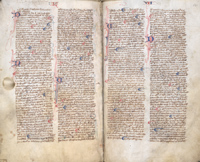 |
 |
 |
 |
 |
 |
 |
|
The process (9/13)
The bloodletting took place in the warming-house, usually in the late morning or early afternoon. A fire was lit in preparation and the monk could have a bite to eat in the refectory before undergoing the procedure. He would certainly need this extra sustenance for the monk was drained to the point of unconsciousness and might lose up to four pints of blood. This weakened him considerably and he required time to recuperate. In the twelfth century, he recovered in the dormitory, cloister and chapter-house, but from the early thirteenth century the monk rested in the infirmary where he enjoyed a more relaxed diet and relief from the daily round of work and liturgical offices. During this period of recovery,
the monk did not participate
in the chants; nor did he read. Most monks who held an office
(obedientiary) were
not expected to carry out any of their duties after they
had been bloodlet, and their deputies filled in. This did not apply
to the main office-bearers,
such as the prior, sacrist, cellarer and novice-master.
On the third day after his bloodletting, the monk joined the
rest of the community for some
of the Offices and
might read in the cloister; on the fourth day he was expected to play
a full part in the daily life,
although he did not necessarily
engage in manual labour.
|
